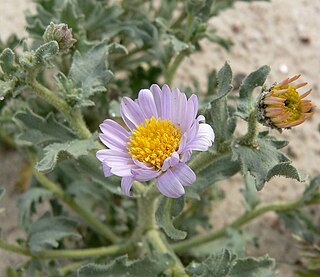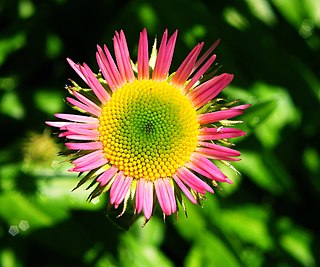Related Research Articles

Ionactis, common name stiff-leaved Asters or ankle-asters, is a small genus of plants belonging to the daisy family. These aster-like plants are endemic to North America. One species is widespread across much of the eastern half of the continent, while two others are rare endemics with very restricted ranges.

Symphyotrichum is a genus of over 90 species of herbaceous annual and perennial plants in the composite family (Asteraceae) that were formerly treated within the genus Aster. The majority are endemic to North America, but several species also occur in the West Indies, Central and South America, as well as in eastern Eurasia. Many species have been introduced to Europe as garden specimens, most notably New England aster and New York aster.

Astereae is a tribe of plants in the family Asteraceae that includes annuals, biennials, perennials, subshrubs, shrubs, and trees. Plants within the tribe are present nearly worldwide divided into 170 genera and more than 2,800 species, making it the second-largest tribe in the family behind Senecioneae. They are found primarily in temperate regions of the world.

Arida is a genus of flowering plants in the daisy family, Asteraceae.
Astranthium, or Western-daisy, is a North American genus of flowering plants in the daisy family. Astranthium is native to the United States and Mexico.
Benitoa is a genus of flowering plants in the daisy family, Asteraceae.
Chrysoma is a genus of flowering plants in the daisy family.
Gundlachia, commonly called Goldenshrub, is a genus of flowering plants in the daisy family.
Laennecia or Laënnecia is a genus of flowering plants in the sunflower family. The plants are native to Mesoamerica, South America, and the southwestern United States. Common name is "horseweed."
Neonesomia is a genus of North American flowering plants in the aster tribe within the sunflower family.

Oreostemma is a genus of flowering plants in the daisy family, Asteraceae. Species are found in western North America, with two endemic to California.

Podocoma is a genus of South American plants in the aster tribe within the sunflower family.
Psilactis is a genus of North American and South American plants in the aster tribe within the sunflower family which are known by the common name tansyaster.
Tonestus, common name serpentweed, is a genus of North American flowering plants in the aster family.

Xanthisma, common name sleepy-daisy, is a genus of flowering plants in the sunflower family.
Xanthocephalum is a genus of North American plants in the aster tribe within the sunflower family.

Symphyotrichum lanceolatum is a species of flowering plant in the family Asteraceae native to North America. Common names include lance-leaved aster, panicled aster, and white panicled aster. It is a perennial, herbaceous plant that may reach 1.5 meters tall or more, sometimes approaching 2 meters. It has a stout rhizome and can spread to form a clonal colony. The species is currently divided into five varieties which have minor differences in appearance and vary in chromosome counts as well as distribution, with some overlap.
Astranthium integrifolium is a North American species of flowering plants in the daisy family. It is native to the east-central part of the United States primarily the Cumberland Plateau and Ohio/Tennessee Valley. It is found in the States of Tennessee, Kentucky, Alabama, and Georgia, with isolated populations in Mississippi and West Virginia.
Astranthium ciliatum, or Comanche western-daisy, is a North American species of flowering plants in the daisy family. It is native to the southern part of the Great Plains of the central United States, with the range continuing southward into northeastern Mexico. It is found in the States of Nuevo León, Tamaulipas, Texas, Oklahoma, Arkansas, Missouri, and Kansas.
Erigeron klamathensis is a North American species of flowering plant in the daisy family known by the common name Klamath fleabane. It had been collected by botanists for many years and generally regarded as part of the species E. foliosus. It was not recognized as a distinct species until 2004.
References
- 1 2 Flann, C (ed) 2009+ Global Compositae Checklist Archived 2014-11-15 at Archive.today
- ↑ The Plant List, Columbiadoria hallii (A.Gray) G.L.Nesom
- ↑ Nesom, Guy L. 1991. Redefinition of Hesperodoria (Asteraceae: Astereae) and the segregation of Columbiadoria, a new monotypic genus from the western United States. Phytologia 71(3): 244–251
- ↑ Botanic Garden and Botanical Museum Berlin-Dahlem. "Details for: Astereae". Euro+Med PlantBase. Freie Universität Berlin . Retrieved 2009-07-18.CS1 maint: discouraged parameter (link)
- ↑ UniProt. "Tribe Astereae" . Retrieved 2009-07-18.
- ↑ Tropicos, Columbiadoria G.L. Nesom
- ↑ Biota of North America Program 2013 county distribution map
- ↑ Turner Photographics
- ↑ Paul Slichter, Columbia River Daisy, Hall's Columbiadoria, Hall's Goldenweed, Columbiadoria hallii